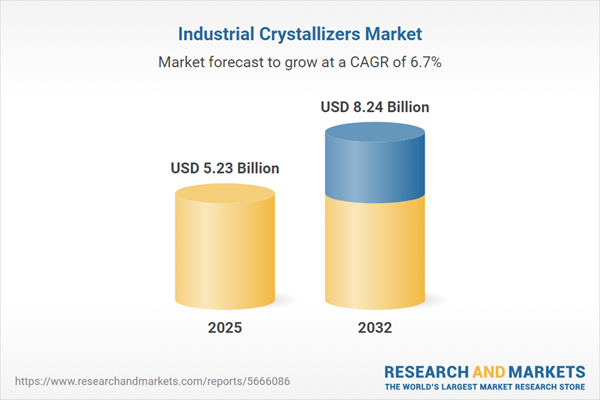Speak directly to the analyst to clarify any post sales queries you may have.
The industrial crystallizers market is transforming as sustainability, digitalization, and global trade pressures reshape technologies and investment drivers. This report equips senior decision-makers with actionable market intelligence for navigating complex procurement, operational, and strategy decisions in crystallization systems.
Market Snapshot: Industrial Crystallizers Market Outlook
The Industrial Crystallizers Market grew from USD 4.89 billion in 2024 to USD 5.23 billion in 2025. With continued momentum, it is on track for sustained growth at a CAGR of 6.72%, reaching USD 8.24 billion by 2032. Market development is driven by a combination of technology enhancements, regulatory changes, evolving sustainability requirements, and advanced digital integration across end-use industries.
Scope & Segmentation
This report delivers in-depth analysis across segments, technologies, and regions influencing the industrial crystallizers market. Key segmentation and coverage include:
- Type: Centrifugal Crystallizers, Cooling Crystallizers (Expanded Surface, Plate, Shell and Tube), Draft Tube Baffle Crystallizers, Fluidized Bed Crystallizers, Vacuum Crystallizers (Batch Vacuum, Continuous Vacuum)
- End Use Industry: Chemical & Petrochemical (Fertilizers, Petrochemicals, Specialty Chemicals), Food & Beverage (Confectionery, Dairy, Sugar), Mineral Processing (Minerals, Ores), Pharmaceutical (API, Excipients)
- Material: Inorganic (Metals, Minerals, Salts), Organic (Pharmaceuticals, Polymers)
- Capacity: Large Scale, Medium Scale, Small Scale
- Sales Channel: Aftermarket (Maintenance Services, Spare Parts), OEM (Direct Sales, Distributors)
- Region: Americas (United States, Canada, Mexico, Brazil, Argentina, Chile, Colombia, Peru), Europe, Middle East & Africa (United Kingdom, Germany, France, Russia, Italy, Spain, Netherlands, Sweden, Poland, Switzerland, United Arab Emirates, Saudi Arabia, Qatar, Turkey, Israel, South Africa, Nigeria, Egypt, Kenya), Asia-Pacific (China, India, Japan, Australia, South Korea, Indonesia, Thailand, Malaysia, Singapore, Taiwan)
Leading companies analyzed include GEA Group Aktiengesellschaft, Alfa Laval AB, SPX Flow, Inc., Veolia Environnement S.A., Evapco, Inc., Andritz Aktiengesellschaft, Sulzer Ltd, Praj Industries Limited, De Dietrich Process Systems GmbH, and Croll-Reynolds Hafer Equipment Company.
Key Takeaways for Senior Decision-Makers
- The choice of crystallizer type is fundamental for performance, capital efficiency, and long-term process flexibility across diverse feedstock and purity requirements.
- Industry focus is shifting to energy-efficient and sustainable crystallizer designs as operators adapt to stringent environmental regulations and cost optimization mandates.
- Digital process analytics, machine learning, and predictive maintenance are driving new operational efficiencies, supporting real-time process control and reduced unplanned downtimes.
- Customization of materials and modularity is becoming standard, with end-users aligning sourcing decisions to support supply chain continuity in volatile markets.
- Regional approaches are essential, as investment patterns, regulatory priorities, and value chain structures vary significantly between the Americas, EMEA, and Asia-Pacific.
- Strategic partnerships—spanning OEMs, engineering service providers, and research institutions—are advancing competitive differentiation through expanded technology portfolios and service offerings.
Tariff Impact: US 2025 Tariff Revisions
Recent US tariff adjustments directly affect industrial crystallizer procurement by increasing costs of imported metal alloys, polymers, and critical heat exchanger components. Organizations are reevaluating sourcing strategies, prioritizing local fabrication, supplier diversification, and tariff engineering assessments to maintain resilience and mitigate new cost burdens. These trade policy shifts require proactive alignment of procurement, project, and supply chain strategies.
Research Methodology & Data Sources
This analysis applies a rigorous multi-source approach, combining reviews of academic and industry literature, corporate disclosures, and patent documentation (secondary research), with structured interviews of industry executives, process engineers, and procurement specialists (primary research). Quantitative modeling and data triangulation strengthen the reliability of findings and actionable guidance for all industrial crystallizers stakeholders.
Why This Report Matters
- Empowers senior leaders to assess emerging risks and opportunities in industrial crystallization technology supply and operations.
- Supports informed capital allocation and procurement decisions in light of regulatory and sustainability pressures.
- Enables organizations to benchmark digital integration and sustainability initiatives against leading market practices and peers.
Conclusion
Industrial crystallizers are at the heart of operational efficiency, regulatory compliance, and supply chain continuity for process industries. This report equips decision-makers to leverage innovation and resilience, fostering steady growth and competitiveness in a dynamic market landscape.
Additional Product Information:
- Purchase of this report includes 1 year online access with quarterly updates.
- This report can be updated on request. Please contact our Customer Experience team using the Ask a Question widget on our website.
Table of Contents
3. Executive Summary
4. Market Overview
7. Cumulative Impact of Artificial Intelligence 2025
Companies Mentioned
The companies profiled in this Industrial Crystallizers market report include:- GEA Group Aktiengesellschaft
- Alfa Laval AB
- SPX Flow, Inc.
- Veolia Environnement S.A.
- Evapco, Inc.
- Andritz Aktiengesellschaft
- Sulzer Ltd
- Praj Industries Limited
- De Dietrich Process Systems GmbH
- Croll-Reynolds Hafer Equipment Company
Table Information
| Report Attribute | Details |
|---|---|
| No. of Pages | 182 |
| Published | October 2025 |
| Forecast Period | 2025 - 2032 |
| Estimated Market Value ( USD | $ 5.23 Billion |
| Forecasted Market Value ( USD | $ 8.24 Billion |
| Compound Annual Growth Rate | 6.7% |
| Regions Covered | Global |
| No. of Companies Mentioned | 11 |









